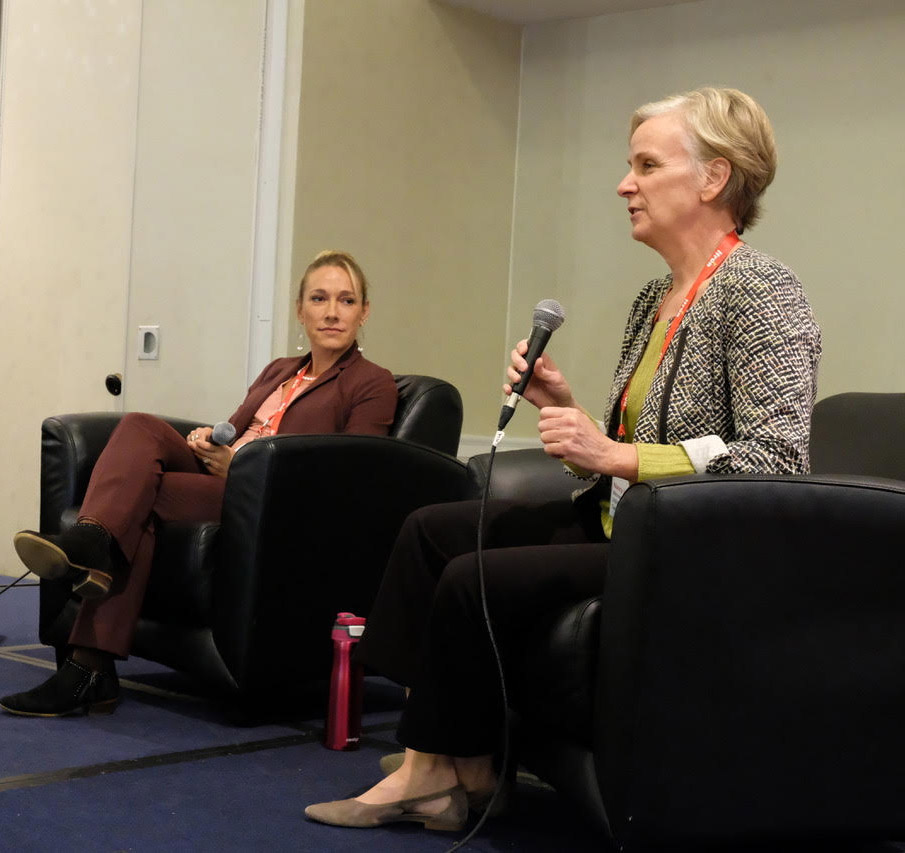Accelerating Grid Modernization

What is Driving Transformation?
The 2018 GridFWD conference, hosted by Smart Grid Northwest, convened around 250 energy service professionals in Vancouver, British Columbia. In a series of articles, Cadmus presents some key themes that emerged regarding grid modernization and the different pathways, priorities, and solutions discussed as next steps in moving this process forward.
By Scott Reeves
Grid modernization is happening. The real question is the rate at which it will occur. Several recent factors have led to renewed excitement and urgency for this process, including electrification trends, decarbonization policy goals, resiliency initiatives, opening markets for new types of technology and competition, and potential analytic solutions using a higher level of data granularity.
Two particularly compelling topics emerged at the 2018 GridFWD conference and gained momentum across several presentations: what is the catalyst for accelerating elements of grid modernization; and what transformations must occur at a utility level to pave the way?
Inevitably, the answers to these questions depend on who you ask. Regarding the first, however, two critical elements appear to indicate the path forward; these primarily involve leadership, which must be effectively paired with stakeholder collaboration. Regarding the second, we will need to understand the existing utility business model and the potential for performance-based regulation (PBR).
Let’s first consider leadership.
Leadership in Grid Modernization
While leadership clearly plays a key role, this critical element derives from many different sources. On the research side, national labs and nonprofit agencies such as the Regulatory Assistance Project (RAP) and Rocky Mountain Institute lay groundwork for understanding technology, running pilots, framing policy issues, and educating industry professionals. Within utilities and other organizations, leaders at various levels, from grid operators to CEOs, are willing to explore innovative opportunities around grid and resource planning as well as cultivating an organizational environment allowing individuals to offer creative solutions to new challenges. The list goes on.
The utility business model and its core values—safe, reliable, and affordable power provision—emerged as a ubiquitous theme throughout the conference proceedings. Though not inherently at odds with grid modernization, these principles can help accelerate certain modernization efforts (such as automated fault detection or automated line switching), impeding progress if risks are perceived to be introduced to those core elements, as in integrating demand-side resources into power planning.Can grid modernization support utility core values?A case for advanced metering infrastructureLearn More
The result of this organizational risk aversion is that sometimes, the utility may not make the first move, especially in areas with uncertain results (for example, developing alternatives to traditional supply options [such as demand response or distributed energy resources {DERs}]).
Due to utilities’ reluctance, legislative and regulatory drivers may present some of the most critical leadership elements needed to prompt utilities to accelerate adoption of demand-side options and other grid modernization functions. In considering how best to persuade risk-averse utilities to get on board with regulatory changes, legislative leadership can consider the incentives that typically speak to utilities’ interest. For example, power supply options with the greatest appeal to utility shareholders have traditionally been those they can capitalize and earn a return on investment. Regulation specifically designed to remove utility disincentives has recently been launched in some jurisdictions with the promise of encouraging investment in demand-side resources.
This brings us to several key concepts that, while not new to the industry, have been gaining momentum around pathways to grid modernization efforts: performance-based regulation or ratemaking (PBR); and performance incentives mechanisms (PIMs). As defined in a 2017 NREL report, “PBRs provide a regulatory framework to connect goals, targets and measures to utility performance or executive compensation. For some enterprises, PBRs determine utility revenue or shareholder earnings based on specific performance metrics and other non-investment factors.”
PIMs relate to PBR as the discrete components driving the new earnings mechanisms––these can be targets, incentives, or other performance metrics that influence performance-based outcomes, which can manifest as carrots or sticks. Currently, several utilities are preparing to outline sets of potential PIMs to lead into discussions with their regulators regarding which should be priorities and ultimately codified. Here, the stakeholder engagement process is key–the range of potential metrics is vast, with some easier or harder to quantify, others aligned with local and regional policy goals.
Why PBR Now?
A paradigm shift emerges in the power sector that encourages the business models to evolve from cost-of-service regulation to performance-based regulation. Sustainable business models and strategic visions underlie current policies driving performance-based regulation initiatives.
Though popular in recent discourse regarding the future of utilities, the notion of a “utility death spiral” arose from concrete examples of distributed generation and energy efficiency creating a loss of sales and stranding utility-owned assets (Kind 2013). Following the term’s introduction to utility discussions, distributed energy resources have grown beyond energy efficiency and customer-sited solar; they now entail a broader mix that includes demand response, electric vehicles, and battery storage—further complicating matters. The emergence and acceleration of such DER resources, along with strategic electrification in buildings and transportation, present new challenges for utilities: how to effectively address a new mix of customer needs and regulatory mandates for clean power, while still delivering on core values and meeting increasingly dynamic customer loads.
For generations, cost-of-service regulation—the dominant mode of regulation—has relied on utilities recovering their costs of service and earning a fair rate of return on power system investments. This approach minimizes risk to utilities and encourages increased energy sales as well as an expanding rate base. These incentives, however, tend to lead to overinvestments of capital resources (i.e., the Averch Johnson effect).
Moreover, PBR allows an alignment of financial incentives with public policy goals. These goals may include promoting clean power (i.e., decarbonization), improved resiliency, or increased customer-centric offerings (e.g., DERs). Implementing PBR requires shifting the ability to maximize utilities’ rates of return from building capacity and selling energy to earning incentives through specific performance metrics. This structure allows revenues to increase as utilities improve performance and hit milestones tied specifically to value-creation related to policy goals rather than to increases in capital investments. In other words, it decouples revenues from sales.
“Exploring discrete areas of utility service, where the PUC can allow utilities to earn a return on outcomes rather than on capital expenditures, will reduce tensions with competitive providers and provide incentives for innovation while leading to the best results for utility customers.”
– OR PUC 2018
PBR Implementation: Insights from Three States
The Policy and Markets session that kicked off GridFWD reviewed approaches to incentivize utility offerings, including approaches taken in Hawaii and Oregon.
Elaine Prause, senior regulatory affairs advisor at the Oregon PUC, described the stakeholder process launched via SB 978. Passed in 2017, SB 978 requires the PUC to establish a public process for considering new regulatory approaches that continue to earn fair compensation for safe and reliable energy, while encouraging other policy objectives, including low-carbon systems, environmental justice, and expanding customer options (OR PUC 2018).
Utility incentive alignments through PBR served as a key component in this conversation, providing the right signals to encourage utility cooperation while ensuring tools remain available to mitigate unintended consequences. Prause noted that the biggest challenge in transitioning to PBR arose from finding new ways to work with stakeholders; this depended on building new relationships, having honest conversations, and carving out time to plan, prioritize, and communicate.
Jennie Potter, Commissioner of the Hawaii PUC, related a similar process taken in Hawaii to develop mechanisms for launching PBR. Mechanisms used included revenue caps, multiyear rate plans, and major investment project recovery. In Hawaii, the process was driven by an interest in moving away from cost-of-service mechanisms to take a more active role in guiding the outcomes.
As in Oregon, Hawaii initiated a stakeholder process, led by the commission, where goals, outcomes, and metrics were considered via a series of briefs and technical workshops. Goals included enhancing the customer experience (e.g., transportation electrification), improving utility performance, and advancing societal outcomes (e.g., DER asset effectiveness, resiliency). (Hawaii Commission 2014)

In a subsequent plenary session (Keeping Up the Pace of Change), Commissioner Potter further detailed the process in Hawaii, citing its open PBR docket and the critical role played by stakeholder involvement, with external organizations such as national laboratories, DOE, and RAP providing pivotal elements. While the commission took the lead in preparing an initial report, establishing draft goals, outcomes, and metrics to move the new regulatory design forward, technical workshops served as the means for fleshing out these issues and solidifying answers.
In the same session, Minnesota PUC Commissioner (Chair) Nancy Lange presented an overview of a similar approach in her state. In 2017, the Minnesota PUC issued a Request for Comments around establishing utility performance goals, methods to measure or evaluate these, and ways incentives could link to discrete performance metrics. This sparked a year of stakeholder engagement, comprising public, private, and nonprofit sector involvement. (MN PUC 2018, MN PUC 2019)
When asked what the commission had been able to accomplish in creating a space for forward-looking consideration, Lange indicated the integrated resource-planning process provided an opportunity to consider changes in customer interest and technology, which in turn paved the way for the current dialogue around grid modernization. Lange also highlighted the importance of the stakeholder process, which proved critical in providing technical expertise and resources, including written comments, technical conferences, and working groups that involved local and national leadership.
Moving Forward
To make the shift from cost-of-service business models to a PBR framework, stakeholders need to establish a set of clearly defined goals and metrics for structuring PBR incentives. These may include incentives and penalties for achieving, surpassing, or falling short of goals. As the GridFWD sessions made clear, jurisdictions undertaking PBR have learned to focus on leadership—the need for an entity such as a PUC to champion this process, take the reins, coordinate stakeholder involvement, invite input (and collaboration) as well as the need for a stakeholder process to engage and elicit feedback and perspectives from all actors. These participants include environmental advocacy groups, utilities, ratepayer and consumer advocates, local government planners, and others. These two elements will prove crucial for ensuring a transition to PBR.
More GridFWD Insights
Defining Grid ModernizationLearn MoreThe Future Grid: Collaboration or Competition Between Utilities and Tech Firms?Learn More
References
Hawaii Commission. 2014. “Exhibit A: Commission’s Inclinations on the Future of Hawaii’s Electric Utilities: Aligning the Utility Business Model with Customer Interests and Public Policy Goals.” White Paper. https://puc.hawaii.gov/wp-content/uploads/2014/04/Commissions-Inclinations.pdf
Hawaii State Legislature. 2019. “2019 Archives SB2939 SD2: A Bill for an Act Relating to Energy.” https://www.capitol.hawaii.gov/Archives/measure_indiv_Archives.aspx?billtype=SB&billnumber=2939&year=2018
Kind, Peter. 2013. Disruptive Challenges: Financial Implications and Strategic Responses to a Changing Retail Electric Business. Edison Electric Institute.
Minnesota Office of the Revisor of Statutes. Accessed 2019. “2018 Minnesota Statutes: 216B.16 Rate Change.” https://www.revisor.mn.gov/statutes/cite/216b.16
Minnesota Public Utilities Commission (MN PUC). January 8, 2019. “Order Establishing Performance-Incentive Mechanism Process.” Docket No. E-002/CI-17-401. https://www.edockets.state.mn.us/EFiling/edockets/searchDocuments.do?method=showPoup&documentId={F0E82E68-0000-CF1F-93DB-4CE874187020}&documentTitle=20191-148970-01
Minnesota Public Utilities Commission (MN PUC). November 1, 2018. “In the Matter of a Commission Investigation to Identify and Develop Performance Metrics and, Potentially, Incentives for Xcel Energy’s Electric Utility Operations.” Staff Briefing Papers. https://www.edockets.state.mn.us/EFiling/edockets/searchDocuments.do?method=showPoup&documentId={5009AC66-0000-C113-8524-DA9A152B4B30}&documentTitle=201810-147287-01
National Renewable Energy Laboratory (NREL). September 2017. Next-Generation Performance-Based Regulation: Emphasizing Utility Performance to Unleash Power Sector Innovation. Technical Report NREL/TP-6A50-68512. https://www.nrel.gov/docs/fy17osti/68512.pdf
Oregon Legislative Assembly. 2017. “Enrolled Senate Bill 978.” Sponsored by Committee on Business and Transportation. https://www.puc.state.or.us/Renewable%20Energy/SB%20978_Bill.pdf
Oregon Public Utility Commission (OR PUC). September 2018. SB 978 Actively Adapting to the Changing Electricity Sector. Legislative Report. https://www.puc.state.or.us/Renewable%20Energy/SB978LegislativeReport-2018.pdf